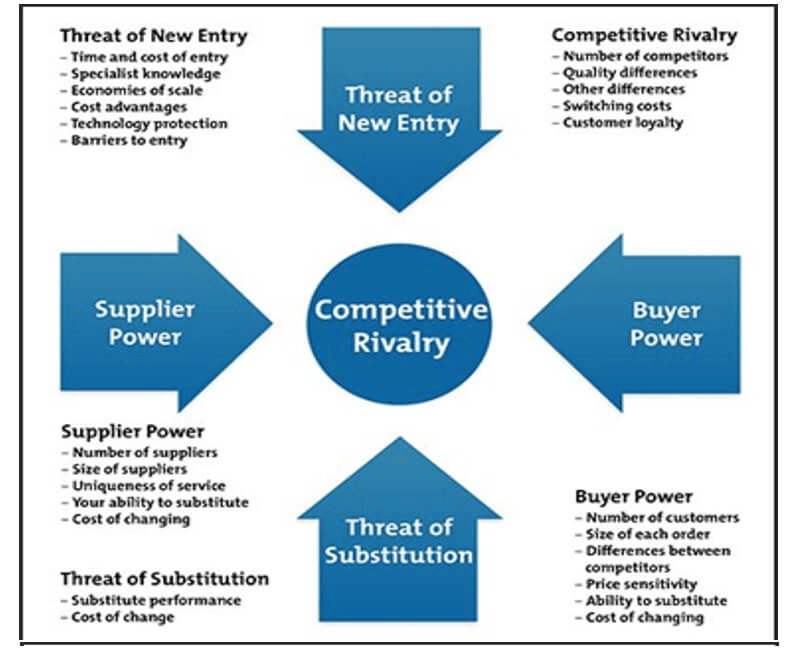
A useful way of gaining insights into competitors and the competitive environment is through industry analysis. Porter’s five forces model is a framework that helps understand the competitive patterns within the industry in which a firm operates.
Introduction
An Industry is “a group of firms that produce products that are close substitutes for each other. Porter (1985) suggested that in order to be an successful player, a firm must understand the competitive patterns in its industry as the pressure from any of these forces can limit its profitability.
Porter’s five forces is a framework that is commonly used to analyse competition in an industry, before a new entrant decides to enter that market (Porter, 2008).
Porter offers his Five Forces model of competition as a means of understanding industry environments and suggests that “competitive generic strategies” are adopted in the light of an environmental analysis to achieve a competitive industry position.
The five forces are:
- Threat on new entrants: How easy is it for a new entrant to enter the market?
- Bargaining power of suppliers: How much power are the suppliers able to influence?
- Bargaining power of buyers: How much power are the buyers able to influence?
- Threat of substitute product: What are the alternatives available to the consumers?
- Existing competition/rivalry: Who are the competitors?
While this framework is commonly used by incumbent companies to analyse how competition is shaping up in the market, it can be used by new entrants to understand the various forces, especially the competitors that are in a leading position in the market.
The Five Forces analysis helps the firm to stay competitive by:
- Knowing the strength of these five forces, one can develop strategies that help their businesses be more competitive and profitable.
- Looking at opportunities, one can strengthen their organization’s position compared to the other players for reducing the competitive pressure as well as generate competitive advantage.
- It helps understand which industries/markets to enter or leave
- It helps understand what influence can be exerted?
- The forces may have a different impact on different organisations within the same industry
Porter’s Five Forces
Supplier Power
It represents the extent to which the suppliers can influence the prices. When there are a lot of suppliers, buyers can easily switch to competitors because no supplier can, actually, influence the prices and exercise control in the industry.
Supplier bargaining power is high when:
- The market is conquered by a few big suppliers.
- Uniqueness of their product or service
- The supplier customer base is fragmented, making their bargaining power low.
- High switching costs from one to another supplier.
Buyer Power
The bargaining power of customers looks at customers’ ability to affect the pricing and quality of products and services. When the number of consumers of a particular product or service is low, they have much more power to affect pricing and quality. The same holds true when a large proportion of buyers can easily switch to a different product or service.
Customer bargaining power is high when:
- Customers procure large volumes.
- The supplying industry consists of several small operators.
- The product has substitutes.
- Switching products is easy, simple and does not incur high costs.
Competitive Rivalry
In highly competitive industries, firms can exercise little or no control on the prices of the goods and services. However, when the industry enjoys monopoly, businesses can fully control the prices of goods and services.
Rivalry between existing players is likely to be high when:
- Players are the same size.
- Players have comparable strategies.
- Little or no differentiation between players and their products leading to price competition.
- Low market growth rates.
Market share is one indicator of competitive standing in a market. It is defined as the percentage of sales within a market that is accounted for by a company, brand or product; calculated in units or money (or both).
Threat of Substitution
Where close substitute products exist in a market, it increases the likelihood of customers switching to alternatives in response to price increases. However, when a business follows a product differentiation strategy, it can determine the ability of buyers to switch to the competition.
This threat is determined by things such as:
- Brand dependability of customers.
- Secure customer relationships.
- Switching costs for customers.
- The relative price for performance of substitutes.
Threat of New Entry
When the barriers to entry into an industry are high, new businesses can hardly enter the market due to high costs and strong competition. Some Industries can claim a competitive advantage because their products are not homogeneous, and they can sustain a favorable position.
Possible barriers to entry could include:
References
Porter, M.E. (2008) The Five Competitive Forces that Shape Strategy. Harvard Business Review, 86, 79-93.
BATheories.com is managed by a group of educators from Mumbai. We also manage the website StudyMumbai.com. Our panel includes experienced professionals and lecturers with a background in management. BATheories is where we talk about the various business theories and models for BA (Business Administration) students.

Leave a Reply